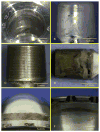Is increased modularity associated with increased fretting and corrosion damage in metal-on-metal total hip arthroplasty devices?: a retrieval study
- PMID: 23910820
- PMCID: PMC3971476
- DOI: 10.1016/j.arth.2013.05.040
Is increased modularity associated with increased fretting and corrosion damage in metal-on-metal total hip arthroplasty devices?: a retrieval study
Abstract
This retrieval study documents taper damage at modular interfaces in retrieved MOM THA systems and investigates if increased modularity is associated with increased fretting and corrosion. One hundred thirty-four (134) heads and 60 stems (41 modular necks) of 8 different bearing designs (5 manufacturers) were analyzed. Damage at the shell-liner interface of 18 modular CoCr acetabular liners and the corresponding 11 acetabular shells was also evaluated. The results of this study support the hypothesis that fretting and corrosion damage occurs at a variety of modular component interfaces in contemporary MOM THAs. We also found that modularity of the femoral stem was associated with increased damage at the head. An analysis of component and patient variables revealed that dissimilar alloy pairing, larger head sizes, increased medio-lateral offsets and longer neck moment arms were all associated with increased taper damage at the modular interfaces.
Keywords: corrosion; fretting; metal on metal; modularity; total hip arthroplasty.
© 2013.
Conflict of interest statement
The Conflict of Interest statement associated with this article can be found at
Figures



References
-
- Viceconti M, Baleani M, Squarzoni S, et al. Fretting wear in a modular neck hip prosthesis. J Biomed Mater Res. 1997;35(2):207. - PubMed
-
- Jacobs JJ, Gilbert JL, Urban RM. Current concepts review — corrosion of metal orthopaedic implants*. J Bone Joint Surg. 1998;80(2):268. - PubMed
-
- Langton D, Jameson S, Joyce T, et al. Accelerating failure rate of the ASR total hip replacement. J Bone Joint Surg Br. 2011;93(8):1011. - PubMed
-
- Hallab NJ, Messina C, Skipor A, et al. Differences in the fretting corrosion of metal–metal and ceramic–metal modular junctions of total hip replacements. J Orthop Res. 2004;22(2):250. - PubMed
Publication types
MeSH terms
Substances
Grants and funding
LinkOut - more resources
Full Text Sources
Other Literature Sources
Medical

